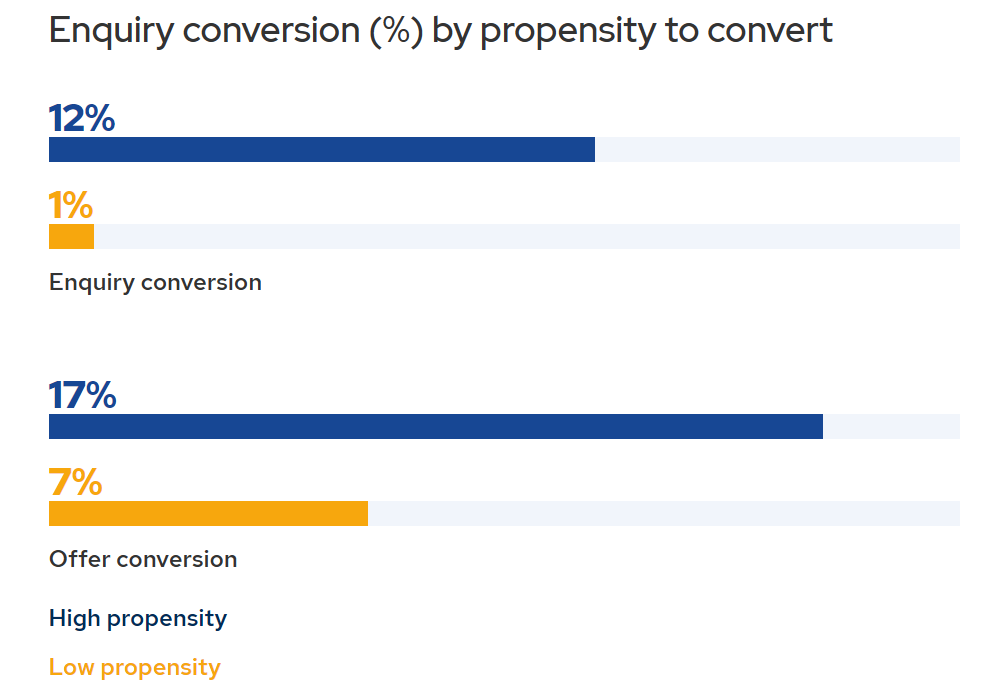
As a sector, are we meeting a critical moment in the evolution of our student recruitment conversion practice? QS Executive Director of Operations Isobel Rossiter discusses how universities can make the most out of their recruitment drives.
Collectively we have willed there to be this moment for so long, where we would see high volumes of student interest, translating into increasing numbers of enquiries, driving huge quantities of applications, and indicating all the potential to push the boundaries of capacity and enrolment figures.
And yet, for many institutions there now lies the challenge of working with this colossal growth to ensure that those students who are the most qualified and have the strongest likelihood to attend their institution are prioritised in a strategic but also highly responsive way.
One of the big questions is how we should look at those virtual piles of enquiries and applications and understand who are the ones that realistically are the right fit. Usually we look for the winning combination of academic qualifications, combined with an actual desire to come to your specific institution, while also ensuring diversification is harnessed and delivered to give an enriching student experience.
Let’s lay the cards on the table, not all leads are created equal. Not all leads have a real, innate desire to attend an institution. Many are hedging their bets, purely speculating over their next steps, or see an institution as the back-up choice. We know that conversion rates from enquiry to enrolment can be as low as one percent. And for so long as a sector, we have collectively tried to push to the back of our minds the pain of acknowledging that all that energy and effort that teams plough into creating responses and building and implementing conversion approaches often ultimately goes nowhere.
Alternative ways of thinking
Thankfully, there is an alternative and creative way of thinking about it. Firstly, we could model those leads and applications based on how they interact with your institution and by the credentials that they demonstrate. Secondly, we can shift conversion strategies so their foundations are based on real truths about applicants’ propensity to convert to enrolments. Furthermore, we can use data modelling to identify which group of students are the most likely to choose you, which ones might choose you, and which definitely won’t, and then work with that data to operationalise your actions accordingly.
Recognising that in a mass market sometimes there does need to be prioritisation. Acknowledging that in a world where demand outstrips supply, ethical enquiry and admissions management may not mean operating in a first come first served environment. Remembering that ultimately our goal is to find those students who have the highest propensity to be successful in their education goals. That is our responsibility, and surely, we are doing them a disservice if we don’t utilise tools in our armoury to support that agenda?
Here at QS Student Recruitment, we have been working with our clients to explore tactical responses to this conundrum. By using AI and data modelling through our Machine Learning model, insight from our International Student Survey and conversion analytics we have challenged our partners to rethink their strategic approaches to conversion communications. Through identifying those patterns of conversion seen in their historical and current student data across a range of demographic components, combined with enquirer and applicant engagement data, it is possible to establish more clearly how those with a higher propensity to convert interact with the institution during the recruitment pipeline.

By clearly identifying where to invest resourcing and conversion energy, QS was able to support clients with insight from our QS International Student Survey to establish clear routes to conversion for those who had the highest propensity to convert.
Communicating with leads
It was wholly apparent that not only were not all leads made equal, but also not all communication methods were made equal either, and in fact continue to evolve as the student demographic adjusts its preferences.
Using the insight below, underpinned with the propensity modelling, QS was able to shape communications strategies with its clients to improve their enrolment outcomes and to provide a more responsive service to students. Here were the observations:
- Despite speculation to the contrary, 88% of students claim to prefer email, making it by far the most popular (and for some, the only) channel. It remains a hugely influential conversion tool, with the QS client group seeing 32% of offer holders being converted through the use of emails and even for enquirers the conversion to enrolment is double that of standard conversion metrics.
- A third of students see phone calls as remaining an effective tool for engagement and this resonates in the QS client data where a third of offer holders had their conversion aided by the use of inbound and outbound phone calls. Particularly for enquirers, the use of phone calling is four time as likely to convert students through to enrolment.
- As communication evolves the use of real-time chat on university websites is now also regarded as highly engaging with 31% of all prospective students selecting this option and a third of offer holders utilising live chat to influence their conversion through to enrolment. Even for enquirers this is starting to build as an influencing channel with conversion rates to enrolment at 2.2% globally.
- 40% of all prospective students would prefer to use social channels such as WhatsApp to communicate with a university in a reactive and responsive way. Although slower to emerge as a critical channel it still has a powerful path for enquirer conversion increasing base line conversion to enrolment to 1.5%.
Through mobilising that theory into practice and combining the understanding of the underlying data with an optimal suite of conversion and communication methods it was possible to fundamentally adjust an institutions enrolment outcomes.
Reminding us all, that only by the use of laser-like analytical precision and clear prioritisation through the student recruitment pipeline, can institutions hope to take enquiry and admissions management from reactive to strategic, and prevent revolving scenarios of fearing the loss of the ones that ‘got away’.



